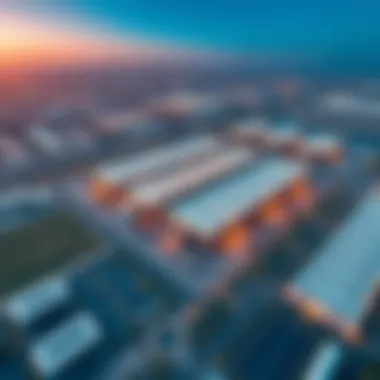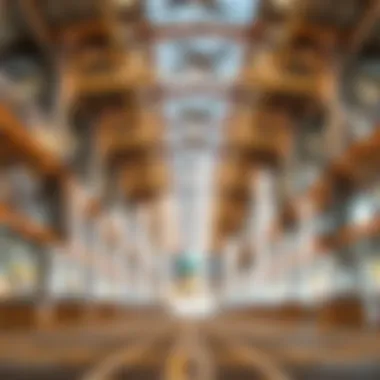Al Ghurair Warehouse Complex: Key Insights and Impact


Intro
Located in the heart of Dubai, the Al Ghurair Warehouse Complex serves as a cornerstone of the city’s logistics framework. With the rapid advancements in trade and commerce, this complex has positioned itself as an essential asset for businesses navigating the competitive market. Its strategic placement and unique architectural features reflect not only modernity but also the burgeoning potential of the logistics sector in the region.
This article takes a closer look at the myriad facets of the Al Ghurair Warehouse Complex, from its historical developments to its operational framework, and outlines why it remains a pivotal space for investors, property buyers, and industry insiders alike.
Market Trends and Insights
An in-depth analysis of the current and historical market dynamics reveals the complex’s influence on the logistics and real estate landscapes of Dubai.
Current Market Analysis
The Al Ghurair Warehouse Complex is currently experiencing a renaissance, driven by the surge in e-commerce and demand for efficient supply chain solutions. The increasing preference for urban logistics spurred by customer expectations has made this warehouse a prime choice for businesses seeking to optimize their distribution networks.
Key Factors Influencing the Market
- Growing urban population focusing on on-demand services
- Enhanced infrastructure developments in Dubai
- Rising investment in technology for supply chain efficiency
- Increased collaboration between various logistical stakeholders
Historical Trends and Future Predictions
Historically, the Al Ghurair complex is no stranger to impactful changes. Established many years ago, it has adapted to market changes and technological advances. Over the past decade, the shift towards automation and digitalization in logistics has set the stage for future expansions and innovative adaptations.
As we gaze at potential forecasts, experts predict robust growth in warehouse space demand in Dubai. With the continued economic development projected in the UAE, the Al Ghurair Warehouse Complex is set to play a vital role in accommodating this growth.
"Dubai's logistics sector has embraced a transformation fueled by technology, making complexes like Al Ghurair pivotal for future success."
Investors and developers alike are encouraged to consider these patterns when evaluating property opportunities within the complex.
Property Listings and Comparisons
Luxury Properties Overview
While the primary focus of the complex is on logistics, it is worth noting that luxury properties in the surrounding area are also on the rise. The demand for high-end commercial spaces is evident, with several notable developments complementing the warehouse complex. These properties are designed with modern amenities and cater to high-profile clientele.
Affordable Housing Options
On the flip side, there has been a growing interest in affordable housing solutions nearby. Initiatives aimed at providing options for the workforce associated with the logistics sector are drawing attention. Such properties ensure that the needs of all demographics are met, enhancing the appeal of the complex.
Intro to Al Ghurair Warehouse Complex
The Al Ghurair Warehouse Complex is not just a string of buildings and storage spaces; it’s a cornerstone in Dubai’s logistics narrative. The sheer magnitude of this establishment is remarkable, positioning it as a hub that feeds into and supports the wider economic fabric of the region. Everyone from local business owners to international investors should take note of its significance. This complex embodies the synergy between innovation and tradition, offering vital insights into how modern logistics operate in a bustling metropolis.
Historical Context
The history of the Al Ghurair Warehouse Complex can be traced back to Dubai’s rapid economic growth phases in the late 20th century. Initially designed to cater to the booming trade dynamics of that era, this facility has evolved over the decades along with the city itself. The early days saw it primarily handling basic warehousing needs, serving small businesses looking for storage solutions. However, as demand surged and the logistics sector matured, so did the complexity and capabilities of the complex.
By the early 2000s, it had transformed into a state-of-the-art facility equipped to meet the demands of a globalized economy. Its strategic location in the heart of Dubai’s commercial sector made it particularly valuable, facilitating easy access to key trade routes and transport hubs.
The lineage of Al Ghurair is rich and intertwined with the broader economic tapestry of Dubai. Thanks to pioneering leadership and an unwavering vision, the complex has adapted to ever-changing market demands. The buildings not only reflect architectural prowess but also echo the stories of countless businesses that have flourished within their walls.
Objectives of the Complex
The objectives behind the Al Ghurair Warehouse Complex are multifaceted, reflecting a commitment to not just economic output, but also community engagement and sustainability. The complex serves several critical functions:
- Support Local Business: One of the primary goals is to provide small and medium enterprises with the necessary infrastructure to thrive. Many startups in the region depend on accessible warehousing solutions that reduce overhead costs, making entrepreneurship attainable.
- Facilitate Trade: Given its prime location, the complex aims to enhance trade efficiency. It offers businesses an opportunity to manage inventory and logistics without the heavy burden of extensive initial investment.
- Sustainability Initiatives: Another ongoing objective is to adapt to modern sustainability practices. The management invests in green technologies and efficient resource management to minimize the environmental impact. This proactive approach not only appeals to eco-conscious investors but sets a standard for future developments in the region as well.


In summary, the Al Ghurair Warehouse Complex is not merely a site for storage; it stands as an emblem of Dubai’s aspirations, embracing growth and innovation while catering to the needs of both businesses and the environment.
Architectural Design and Features
The architectural design and features of the Al Ghurair Warehouse Complex playa crucial role in the functionality and aesthetic appeal of the facility. This section delves into the core components that define the complex, showcasing how these elements contribute to its operational efficiency and market positioning. Understanding these architectural nuances offers invaluable insight for investors and stakeholders, revealing what sets this facility apart in a highly competitive landscape.
Structural Layout
The structural layout of the Al Ghurair Warehouse Complex is more than just a framework; it’s an intricate design that maximizes both space utilization and workflow. Encompassing multiple warehouses and distribution hubs, the spatial arrangement is meticulously planned. For instance, the segmentation of storage areas allows for differentiated handling of various goods. This segmentation is pivotal, especially when considering the rapid turnaround times required in modern logistics.
A notable feature of the layout is the high ceilings that facilitate vertical storage options. By using the height of the warehouses, companies can store more inventory without expanding their footprint. Moreover, the open floor plan minimizes obstruction and ensures smooth operations, reducing the likelihood of accidents, which is paramount in warehousing.
Furthermore, the clear demarcation of zones for inbound and outbound logistics helps streamline processes, ensuring that goods move efficiently through the supply chain. This separation is particularly essential in avoiding congestion during peak operational hours.
"The design is not just about looks; it’s about functionality tailored for optimal performance."
Innovative Technologies Used
In the realm of warehousing, staying ahead means adopting cutting-edge technologies, and the Al Ghurair Warehouse Complex exemplifies this approach to innovation. The use of advanced logistical software systems for inventory management is a game changer. These systems enable real-time tracking of goods, which significantly enhances transparency and reduces errors in order fulfillment.
Additionally, automation is transforming the warehousing landscape. Automated guided vehicles (AGVs) and robotic systems are employed to assist with picking and packing, which not only speeds up operations but also minimizes the risk of human error. In this regard, the complex stands at the forefront of technological advancements in logistics.
Moreover, smart building technologies are integrated throughout the complex. These systems manage energy efficiency, lighting, and climate control automatically, which contributes to sustainability and cost management. By monitoring and adjusting real-time usage, the complex reduces its overall environmental footprint—an increasingly important factor in commercial real estate.
The architectural design, paired with these innovative technologies, creates a facility that is not only functional but is also positioned as a leader in the logistics sector. Investors and stakeholders keen on sustainability and efficiency will find the strides taken at the Al Ghurair Warehouse Complex particularly compelling.
Operational Framework
Understanding the operational framework of the Al Ghurair Warehouse Complex is essential for grasping its significance in Dubai's logistics sector. This framework encompasses various elements that contribute to the efficient running of operations within the facility. It sets the stage for effective logistics and supply chain management, ensuring that goods move seamlessly through the various stages of distribution. Moreover, a well-designed operational framework provides the foundation for sustainability in commercial practices, aligning with global trends towards environmentally responsible approaches.
Logistics and Supply Chain Management
Logistics and supply chain management form the backbone of any successful warehouse operation. In the case of the Al Ghurair Warehouse Complex, the focus is on creating an agile and responsive supply chain that can meet the ever-changing demands of the market. Key components include:
- Inventory Management: The complex utilizes cutting-edge systems that track inventory levels in real-time. This capability minimizes stockouts and reduces overhead costs, giving businesses the agility needed in today's fast-paced market environment.
- Distribution Networks: A comprehensive distribution strategy allows for efficient routing and scheduling of deliveries. The proximity of the Al Ghurair Warehouse to key transportation hubs ensures that goods reach their destinations quickly, enhancing customer satisfaction.
- Data-Driven Decision Making: Advanced analytics are employed to optimize supply chain processes. These tools provide insights into market trends and customer preferences, enabling stakeholders to make informed decisions.
By streamlining logistics and employing innovative supply chain strategies, the Al Ghurair Warehouse Complex positions itself as a critical player in Dubai's economy. Businesses leveraging this infrastructure can expand their market reach and improve operational efficiencies, aligning with the principles of modern supply chain management.
Sustainability Practices
In an era where environmental concerns are at the forefront, the Al Ghurair Warehouse Complex is taking noteworthy strides in sustainability. This focus on eco-friendly practices not only supports corporate social responsibility but also attracts environmentally conscious investors and customers. Key sustainability practices include:
- Energy Efficiency: The complex incorporates energy-efficient systems and technologies. From LED lighting to smart HVAC systems, these measures help reduce the overall carbon footprint.
- Waste Management: A robust waste management system is in place, emphasizing recycling and responsible disposal alternatives. By minimizing waste, the complex contributes to a more sustainable business environment.
- Sustainable Sourcing: Engaging with suppliers who share a commitment to sustainability ensures that the materials and products that come through the complex adhere to eco-friendly standards.
"Sustainability isn't just a nice-to-have; it's a must-have in today's competitive market."
As we analyze these operational frameworks, it becomes clear that the strength of the Al Ghurair Warehouse Complex lies not only in its logistical capabilities but also its dedication to sustainable growth, making it an attractive option for investors and businesses alike.
Market Positioning
Understanding the market positioning of the Al Ghurair Warehouse Complex is essential for multiple stakeholders in the logistics and real estate sectors. This section addresses its strategic standing and outlines the unique advantages that set it apart from competitors. The importance of market positioning lies not just in its current operations but in its broader implications for future developments and investments in the region.
Competitive Analysis
When assessing the Al Ghurair Warehouse Complex in relation to its competitors, it becomes clear that it offers distinct advantages. For example, it stands in close proximity to major highways and Dubai International Airport, which is a major boon for logistics operations. This location facilitates not just efficient transportation but also enhances flexibility in supply chain operations.
Moreover, the complex integrates state-of-the-art technology, allowing for improved inventory management and real-time tracking of goods. Companies like Agility and DB Schenker, which have warehouses nearby, often find themselves rivaling not just on price but on operational efficiency. Al Ghurair, with its modern infrastructure, positions itself as a front-runner in embracing digital logistics, catering efficiently to a tech-savvy clientele.


Additionally, the lease structures at the Al Ghurair complex are notably flexible. This adaptability is crucial in a market that often faces fluctuations in demand. Companies looking for shorter-term leases to gauge market conditions may find this an attractive feature, making the complex a favored choice for both established brands and startups.
"The ability to pivot and adapt to market changes is a hallmark of the Al Ghurair Warehouse Complex, making it an attractive destination for diverse businesses."
Target Demographics
Understanding the target demographics for the Al Ghurair Warehouse Complex is key to grasping its market strategy. The clientele ranges from established corporations to emerging startups, thus showcasing a versatile appeal.
- E-commerce Giants: With the sharp increase in online shopping, companies such as Noon and Amazon in the UAE are likely to benefit from the strategic implications of being located within this complex. These businesses require extensive warehousing solutions to handle their growing logistics needs.
- Manufacturing Firms: Given the proximity to raw material suppliers and shipping routes, manufacturers can find the complex an advantageous place to store inventory and manage logistics efficiently.
- Retail Chains: Traditional retail businesses, including local brands, are increasingly recognizing the need for efficient supply chain management facilitated by warehouses close to their main markets. The Al Ghurair Complex meets such requirements adeptly.
- Startups in Logistics: Younger companies are less entrenched in lengthy lease agreements and capital investments. They find that the Al Ghurair’s flexible leasing and high-tech facilities can be transformative for their operations.
In summary, the Al Ghurair Warehouse Complex successfully caters to a broad spectrum of industries. This strategic marketing approach not only enhances its presence but also supports its sustained growth in the highly competitive market of Dubai's logistics sector.
Economic Impact
The economic impact of the Al Ghurair Warehouse Complex is substantial, playing a pivotal role in the ongoing development of Dubai's logistics sector. This complex is more than just a facility for storage; it represents a broader ecosystem that fosters trade, supports local businesses, and generates considerable revenue for the region. Analyzing its components sheds light on its significance in enhancing economic vitality.
Contribution to Local Economy
The Al Ghurair Warehouse Complex acts as a keystone in the local economy. By providing modern storage solutions and infrastructure, it streamlines supply chain processes, which can greatly reduce transit times for goods. This efficiency can lead to cost savings for local retailers and wholesalers, enabling them to price their products more competitively. More than just a warehouse, it's a catalyst for growth that uplifts entire communities.
- Boosting Trade: The complex directly supports import and export activities. Businesses utilizing its facilities can manage goods efficiently, enhancing their operational capacities. As Dubai continues to be a hub for international trade, the warehouse enables smoother distribution throughout the region.
- Enhancing Local Businesses: By hosting logistics firms, and ancillary service providers, this complex creates an environment ripe for collaboration. Local companies can thrive through partnerships, shared resources, and innovative solutions that emerge from being in such close proximity to industry leaders.
- Generating Tax Revenue: The operations conducted within the complex contribute significantly to local tax collections, funding essential public services like schools and infrastructure. This financial input is crucial for the continuous development of the area.
Overall, the Al Ghurair Warehouse Complex embodies a blend of innovation and practicality, contributing to vibrant economic growth in the region.
Job Creation and Employment Opportunities
Job creation is another hallmark of the economic influence exerted by the Al Ghurair Warehouse Complex. The facility not only generates direct employment opportunities but also indirectly boosts job prospects across various sectors.
- Direct Employment: The operational needs of the warehouse require a range of roles, from warehouse management and logistics coordination to truck drivers and facilities maintenance staff. This variety opens numerous doors for job seekers, enhancing career prospects in a fast-growing industry.
- Indirect Job Growth: With increased activity within the warehouse, local businesses supplying goods and services experience a surge in demand, leading to hiring boosts in catering, cleaning, security, and more. This ring effect enhances the job market significantly.
- Skills Development: The presence of a well-equipped warehouse complex paves the way for skills development initiatives. It fosters a workforce that is not merely employed but trained in the latest logistics technologies and practices. Potential programs can include workshops, training sessions, and partnerships with educational institutions who seek to enhance vocational training in logistics and supply chain management.
"A thriving warehouse complex has the potential to directly and indirectly create hundreds of jobs and spark economic dynamism across the region."
Regulatory Environment
Navigating the regulatory environment is critical for the Al Ghurair Warehouse Complex as it unfolds within Dubai's bustling trade and logistics landscape. Regulations ensure that developments not only meet safety and operational standards but also fit cohesively into the broader urban fabric. This segment dissects the essential elements that govern the functioning of the complex while highlighting how these regulations translate into tangible benefits for stakeholders.
Zoning Laws and Compliance
Zoning laws play a pivotal role in shaping the operational dynamics of commercial properties, including warehouses. In the case of the Al Ghurair Warehouse Complex, zoning regulations dictate usage, density, and structural guidelines established by local authorities such as the Dubai Land Department and the Dubai Municipality. These rules are vital for ensuring that the complex operates within its designated commercial zones, thereby minimizing conflicts with neighboring residential areas or other land uses.
An in-depth understanding of zoning laws allows the warehouse to efficiently optimize storage, logistics, and transportation operations. Investors and property buyers should keep an eye on the evolving zoning landscape. For instance, shifts in regulations might open new opportunities or impose limitations that could affect market positioning and expansions.
Moreover, compliance with these zoning laws instills a sense of confidence among stakeholders, reassuring them that the complex adheres to the community standards and practices that foster sustainable development.
The regulations are not just rules; they are the backbone that supports a thriving economic environment.
Safety Regulations
Safety regulations in warehouse operations cannot be overstated. The Al Ghurair Warehouse Complex adheres to strict guidelines designed not only to protect the physical structure but, more importantly, the individuals working within it. From fire safety codes to occupational health and safety measures, these regulations ensure that every aspect is meticulously monitored.
The complex utilizes advanced technologies to monitor safety conditions, implementing systems that track environmental factors and personnel movements. Regular audits of safety practices are conducted to ensure compliance with both local and international safety standards, creating a robust operational framework. This commitment to safety extends beyond compliance; it translates into greater investor confidence and potentially lower insurance costs for companies operating within the complex.
In summary, a thorough grasp of regulatory elements—including zoning laws and safety regulations—enhances the functionality and attractiveness of the Al Ghurair Warehouse Complex. Investors and stakeholders in the region should prioritize these aspects to leverage the opportunities presented in this ever-evolving sector.
Future Development Plans


The future of the Al Ghurair Warehouse Complex is not just about maintaining its current operations; it’s about strategic growth that aligns with the ever-evolving landscape of logistics and supply chain management in Dubai. As global trade patterns shift and demand for warehousing solutions increases, the complex stands at a pivotal crossroads. This section delves into the critical aspects of future development plans, highlighting their importance, potential benefits, and essential considerations.
Expansion Considerations
Expanding the Al Ghurair Warehouse Complex involves several dimensions that need careful deliberation. First off, spatial expansion could allow the warehouse to accommodate a diverse array of goods, aiming for both local and international markets. Given Dubai’s strategic position as a trade hub, increasing capacity can mean higher revenue and improved service delivery.
Some factors that could influence expansion decisions include:
- Market Demand: Understanding trends is crucial. Increased e-commerce and retail activities can drive the necessity for more storage space.
- Logistics Partnerships: Collaborating with logistics firms may provide insights into required expansions and operational efficiency.
- Regulatory Compliance: Any expansion must meet local zoning laws and building regulations, ensuring sustainability and safety.
Investing in expansion is like pouring gasoline on a fire—it can amplify the existing momentum of the complex but requires meticulous planning and execution to prevent pitfalls.
Technological Innovations on the Horizon
As we look into the future, technological innovations play a significant role in shaping the Al Ghurair Warehouse Complex’s trajectory. The warehouse is not just sitting on its hands; rather, it is eager to adopt cutting-edge technologies that enhance operations, streamline processes, and elevate customer satisfaction.
Key innovations that are likely on the horizon include:
- Automation in Warehousing: From robotic picking to automated inventory management, embracing these technologies allows for precision and speed. This could become the heartbeat of the warehouse operations.
- IoT Integration: The Internet of Things can facilitate real-time tracking of goods, helping to prevent loss and enhancing inventory accuracy. A connected environment nurtures transparency for clients and stakeholders.
- Sustainability Technologies: With increasing focus on eco-friendly practices, innovations such as energy-efficient systems and waste reduction technologies can establish the complex as a leader in sustainable logistics.
Quote: "Investing in technology is not just about keeping pace; it’s about setting the pace in a fiercely competitive market."
In summary, the future development plans of the Al Ghurair Warehouse Complex promise an exciting evolution. By considering expansion opportunities and embracing technological advancements, this complex is poised to remain a critical player in Dubai’s dynamic logistics scene.
Challenges and Opportunities
In the dynamic world of logistics and warehousing, the Al Ghurair Warehouse Complex finds itself at a crucial intersection of challenges and opportunities. Understanding these elements is vital for stakeholders keen on maximizing the potential this facility offers. The landscape in which this complex operates is influenced by rapid technological advancements, fluctuating market demands, and evolving regulatory pressures. These factors collectively shape its operational strategies and future growth prospects.
Identifying Current Obstacles
Despite its well-established presence, the Al Ghurair Warehouse Complex is not immune to a variety of challenges that can impede its operations. Among the most pressing issues is the ongoing supply chain disruption experienced globally. For instance, increased shipping costs and delays at ports have made managing logistics more complex. Additionally, the warehouse facility has to stay up to date with stringent compliance regulations related to safety and environmental standards. Failure to adhere to these laws can result in hefty fines and operational down time.
- Market Competition: The rise of e-commerce has spurred an influx of new players in the logistics sector, which heightens competition. The need to enhance service offerings and reduce turnaround times is paramount to maintain a competitive edge.
- Technology Integration: The rapid pace of technological change poses a challenge for existing infrastructure. Integrating cutting-edge solutions like automation and data analytics into established systems often involves significant investment and can lead to downtime during transition periods.
Strategic Opportunities for Growth
While challenges are abundant, the Al Ghurair Warehouse Complex also stands on the threshold of numerous strategic opportunities. One key area in which the complex can thrive is through leveraging technological advancements. Automation can lead to enhanced efficiency and reduced operational costs, which is critical in a market defined by tight margins and high consumer expectations.
Moreover, expanding service offerings to meet the demands of e-commerce logistics presents a lucrative avenue for growth. Establishing partnerships with last-mile delivery providers can enhance service reach and customer satisfaction levels.
- Sustainability Initiatives: As businesses become increasingly conscious of their environmental impact, adopting green practices can serve not just as compliance but as a competitive advantage. Eco-friendly warehousing solutions, like solar energy utilization and waste reduction systems, can attract environmentally-focused partners.
- Market Diversification: Tapping into new demographics and sectors can lessen dependency on any single client or industry. For instance, targeting smaller businesses seeking flexible warehousing options may unlock previously untapped revenues.
"Identifying both challenges and opportunities is essential for stakeholders in the logistics and real estate sectors to stay ahead in a fast-changing environment."
In summary, while obstacles exist for the Al Ghurair Warehouse Complex, they are matched by promising opportunities. By adapting and innovating, stakeholders can position themselves favorably in the logistics marketplace and tap into the growing demands of this vibrant sector.
End
The conclusion serves as a significant touchpoint in understanding the broader implications of the Al Ghurair Warehouse Complex. It encapsulates the essence of all the discussions that have unfolded throughout the article, providing a coherent synthesis of vital aspects. This summary isn’t just a wrap-up but an opportunity to reflect on the complexities and nuances that define this crucial hub within Dubai’s logistics landscape.
Summary of Key Insights
The information presented highlights several pivotal insights that are invaluable for a range of stakeholders, from investors to developers. Key takeaways include:
- Historical Foundation: The deep historical roots of the complex illustrate its evolution in response to transforming market demands and logistics necessities.
- Architectural Excellence: The innovative design and structural features distinguish the warehouse as a leader in modern logistic solutions.
- Operational Dynamics: By exploring its frameworks for logistics management and sustainability practices, we uncover how the complex integrates efficiency with environmental responsibility.
- Economic Contributions: The complex plays a crucial role in job creation and bolstering the local economy, underlining its importance beyond merely storage capabilities.
- Future Prospects: The discussion about potential expansions and advancements in technology presents a forward-looking perspective that is crucial for anyone interested in the real estate and economic sectors.
These insights reflect how the Al Ghurair Warehouse Complex is not merely a physical structure but a vital cog in the larger machinery of Dubai's economic framework.
Final Thoughts on Future Prospects
Looking ahead, the future of the Al Ghurair Warehouse Complex appears to be ripe with possibilities. With the logistics sector poised for significant growth, driven by e-commerce and global trade trends, the complex is strategically positioned to leverage these changes. Consider these aspects for future development:
- Technological Integration: As automation and smart logistics continue to evolve, the incorporation of state-of-the-art technologies will be paramount. Investing in AI-driven inventory management systems and data analytics can enhance operational efficiency and responsiveness to market demands.
- Sustainability Initiatives: In light of increasing environmental concerns, future projects should focus on green building practices and sustainable resource utilization, ensuring that the complex adheres to globally accepted sustainability standards.
- Market Adaptation: Continuous evaluation of market trends and client needs will be vital. Flexibility in scaling operations or diversifying services can ensure that the complex remains competitive in changing economic landscapes.















